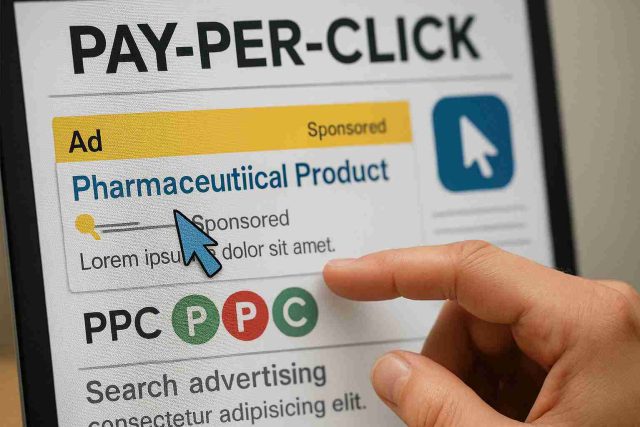In a market saturated with digital noise and tightly regulated messaging, Pay-Per-Click Advertising (PPC) continues to serve as a potent strategy for pharmaceutical marketers. From branded drug campaigns to disease awareness initiatives, PPC is helping pharma companies cut through the clutter. However, with rising costs and complex compliance standards, many in the industry are reevaluating its value. Is PPC still worth the investment for pharma?
Table of Contents
- The Current Role of PPC in Pharma
- Targeting HCPs and Patients: Precision or Pitfall?
- Compliance Constraints and Performance Metrics
- Innovations and the Future of PPC in Pharma
- Conclusion
- FAQs
The Current Role of PPC in Pharma
Pay-Per-Click Advertising has evolved beyond simple search ads. In pharma, it includes sponsored listings on search engines, display networks, and programmatic platforms. These campaigns promote branded medications, patient education content, and clinical trials.
Unlike broader healthcare marketing, pharma ads must pass strict regulatory reviews. This limits the messaging and keywords marketers can use. Yet, when done correctly, PPC remains one of the few digital strategies that delivers immediate visibility and trackable ROI.
Many companies now integrate PPC with omnichannel campaigns. For example, a diabetes drug brand may run display ads while simultaneously sending educational emails. This integrated approach improves both reach and recall. For insights into how pharma marketers use PPC within broader digital ecosystems, explore Pharma Marketing Network.
Targeting HCPs and Patients: Precision or Pitfall?
One of the most lauded aspects of Pay-Per-Click Advertising is its targeting capabilities. Marketers can use demographics, behaviors, search history, and even job titles to zero in on audiences. In pharma, this often means targeting healthcare professionals (HCPs) on LinkedIn or directing patients to branded landing pages.
However, precision targeting is a double-edged sword. Over-targeting may lead to privacy concerns, especially with patient-facing ads. Additionally, keyword restrictions around drug names and conditions can limit campaign flexibility.
Still, the opportunity to reach HCPs directly is unmatched. Whether through sponsored webinars or medical journal placements, PPC helps build brand awareness in niche communities. According to eHealthcare Solutions, programmatic advertising with audience segmentation tools is improving how pharma reaches qualified leads.
Compliance Constraints and Performance Metrics
Regulatory compliance is a major hurdle in pharmaceutical PPC campaigns. Ads must include proper disclosures, balance benefit-risk information, and avoid off-label promotion. This makes crafting compelling yet compliant ad copy a challenge.
Despite this, performance metrics still drive strategy. Click-through rates (CTR), cost per click (CPC), and conversion rates are constantly analyzed. Tools like Google Ads and Meta for Business allow A/B testing and audience segmentation even within tight regulatory boundaries.
Data must also be interpreted cautiously. High CTR doesn’t always translate into meaningful actions, such as prescription requests or increased adherence. Therefore, marketers are shifting to metrics like time-on-site and post-click engagement to better measure ROI.
Furthermore, integrating PPC data with CRM platforms and marketing automation systems helps attribute results across touchpoints. For example, tracking a user’s journey from a search ad to a white paper download offers valuable insight into funnel behavior.
Innovations and the Future of PPC in Pharma
Emerging trends are reshaping how Pay-Per-Click Advertising functions within pharma. AI-driven ad optimization, voice search compatibility, and contextual targeting are enhancing efficiency. Moreover, platforms like YouTube are becoming more valuable for health-related searches.
Interactive content is also on the rise. Instead of static banners, brands are investing in responsive ads, animated explainers, and video testimonials. These formats not only engage users but also comply with FDA guidance when properly developed.
Another game-changer is the adoption of real-world data (RWD) in audience segmentation. By understanding treatment gaps, patient journeys, and medication adherence patterns, marketers can better position their campaigns.
Social media platforms, particularly LinkedIn and X (formerly Twitter), offer paid options tailored to professional audiences. These are ideal for promoting CME courses, white papers, and clinical trial updates.
Nevertheless, the future of pharma PPC will be heavily influenced by privacy laws. Stricter regulations on cookies and data collection may limit tracking capabilities. Therefore, building first-party data ecosystems will be crucial.
Conclusion
Pay-Per-Click Advertising in pharma is not a one-size-fits-all solution, but it remains highly effective when executed strategically. While regulatory challenges and rising ad costs persist, the channel’s ability to deliver immediate, measurable outcomes ensures its relevance.
Pharma marketers must continuously adapt to new tools, audience behaviors, and compliance standards. By integrating PPC with educational content and data analytics, companies can create campaigns that both inform and convert. In this evolving digital environment, PPC is not just working—it’s thriving.
FAQs
What makes PPC different in pharma compared to other industries?
Strict regulatory guidelines limit language, target audiences, and claims, making campaign development more complex.
Is PPC cost-effective for pharma companies?
When targeted correctly and integrated with larger campaigns, PPC can yield high ROI despite higher costs.
Can pharma use branded drug names in PPC?
Yes, but usage must follow FDA and FTC regulations, and include proper disclosures and risk information.
Which platforms are most effective for pharma PPC?
Google Ads and LinkedIn are top choices. YouTube and programmatic platforms are also gaining traction.
How can compliance be ensured in PPC campaigns?
Use pre-approved templates, work with legal teams, and implement monitoring tools to ensure ongoing adherence.
Disclaimer
“This content is not medical advice. For any health issues, always consult a healthcare professional. In an emergency, call 911 or your local emergency services.”
